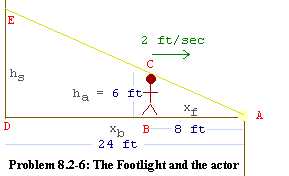

The problem was: Actor, Tyrone Olivier, is exactly 6 feet tall. He delivers a soliloquy on stage, illuminated only by a single footlight, which is at the same level as the floor of the stage. 24 feet behind the footlight is the vertical backdrop of the stage. He begins walking toward the footlight at 2 feet per second. When he is 8 feet from the footlight, at what rate is his shadow on the backdrop increasing in height? The hint was to make a diagram and use similar triangles.

Here's the diagram. Observe that triangle ABC is similar to
triangle ADE. This means that the ratio of lengths,
Answering question 1, we can see that the problem asks for a rate (in time) at which the actor's shadow is growing. So the independent variable is again time, t.
Answering question 2, since the problem asks for the rate at which the shadow height is growing, shadow height, hs, seems an obvious candidate as a dependent variable. That height is the same as length DE. And since the problem talks about his walking toward the footlight, his distance from the footlight, xf, also seems an obvious candidate. That distances is the same as length AB. Note that the height of the actor, ha, and the distance from the footlight to the backdrop, xb, are both constants. These correspond to lengths BC and AD respectively.
Answering question 3, there are no inferred variables in this problem. The dependent variables you came up with answering question 2 covers everything there is about this problem.
Answering question 4, the relationship between the
two dependent variables, xf and hs, are
determined by having similar triangles. A little while back you saw that
the ratio, AB:BC, had to be the same as the ratio,
AD:DE. Isn't this the same as the equation,
xf xb
= eq. p6.1
ha hs
Question 5 tells you to take the derivative with respect to the independent variable of whatever relationship(s) you came up with when you answered question 4. Note that in equation p6.1, the symbols, xb and ha are both constants (the backdrop does not get any nearer or farther from the footlight, and the actor himself does not grow or shrink). Only xf and hs are functions of the independent variable, t. So they are the only ones you take derivatives of. You must treat the constants as scalars (that is they are just along for the ride).
1 dxf xb dhs
= - eq. p6.2
ha dt hs2 dt
Question 6 tells you to solve for whatever the problem is asking for. In this case it is asking for the shadow height the rate at which the shadow grows, which is dhs/dt.
hs2 dxf dhs
- = eq. p6.3
ha xb dt dt
Question 7 tells you to put in the numbers
the problem gives you. These are
hs2 hs2 dhs
- (-2) = = eq. p6.4
144 72 dt
The only difficulty is that you cannot yet plug in a value for hs.
But fortunately
xb 24
hs = ha = × 6 = 18 ft eq. p6.5
xf 8
So in the end equation p6.4 becomes
dhs 182 324What do you suppose the limit is of dhs/dt as the distance from the actor to the footlight, xf, goes to zero?=== 4.5 ft/sec eq. p6.6 dt 72 72
email me at hahn@netsrq.com